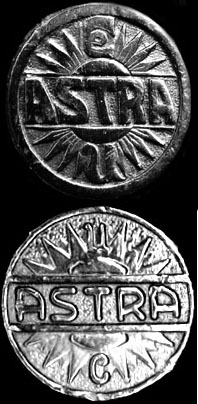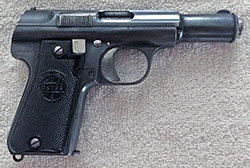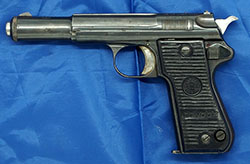 |
||||||||||||||||||||||||||
|
The Astra Tubular Slide Pistols by Ed Buffaloe The Astra Model 400
In August of 1921 the Astra Model 400 (also known as the Model 1921) was approved for use by the Spanish army, and was subsequently adopted by the Spanish Carabineros (Guardia Civil), the prison service, and the navy. Chambered for the 9mm Largo, this gun was based on the Campo-Giro with its tubular slide moving in frame grooves and blowback action, but had an internal hammer and was strongly influenced by the 1903 FN Browning Military pistol as well as the 1910 FN Browning. The Model 400 eliminated the crossbolt that fixed the slide to the frame of the Campo-Giro in favor of a barrel bushing á la Browning, making the gun much easier to disassemble. It also featured a concentric recoil spring, barrel lugs that rotated into recesses in the frame, a grip safety operated by a flat spring, and a Browning-designed Colt-style disconnector. There was no locked breech--like the Campo-Giro and the above- mentioned Browning designs, the Astra 400 was blowback operated. Unique features of the Astra 400 are a sliding sear, a grip safety ratchet that locks the sear, a vertically-moving slide stop, and L-shaped pins that can be pried out rather than punched out. The recoil spring was long and stiff and the slide was made thick and heavy to handle recoil from the powerful cartridge. In addition to the grip safety, the gun also featured a thumb safety, a magazine safety, and a slide that locked open when the last round was fired. Sights were integral, and the magazine held 8 rounds. An unusual and unintended aspect of the Astra 400 was that, due to the long case of the 9mm Bergmann-Bayard cartridge, the gun’s chamber allowed a number of other 9mm cartridges to seat and fire in it, including the 9mm Steyr, the 9mm Parabellum, the .38 Auto, and even the semi-rimmed 9mm Browning Long. The .38 Super will chamber and fire, but has been known to crack slides, as it is too powerful for the Astra, and the 9mm Parabellum can also be dangerous due to the radical headspace difference between it and the Largo. In general, use of incorrect cartridges in any gun is dangerous, due to improper cartridge seating. Nonetheless, men in the field probably took advantage of this “feature” in various conflicts, particularly since 9mm Largo ammunition is scarce outside of Spain. The Model 400 was rust blued (as were all Astra pistols up to 1957). The barrel, barrel bushing, safety, slide lock, and trigger were left in the white and given a high polish. The extractor, grip screws, and magazine release were fire blued. Early grips were made of horn, hard rubber, or mottled brown plastic, with the Astra logo on the upper half. Later grips were of checkered wood (some coarsely checked and some finely checked) with no logo. A rare few featured smooth wooden grips.
The earliest Model 400s (Type I) had the original E/U logo atop the slide and were marked on the rear slide ESPERANZA Y UNCETA, GUERNICA ESPAŅA, PISTOLA DE 9 m/m, MODELO 1921. Later pistols (Type II, starting in the mid-43,000 serial number range) featured the U/C logo on top of the slide and were marked UNCETA Y COMPAŅIA, GUERNICA ESPAŅA, PISTOLA DE 9 m/m (38), MODELO 1921 (400). There are a multitude of minor variations of the Model 400, with many different proof and acceptance stamps--for details on these please refer to Mr. Antaris’ book Astra Automatic Pistols. Serial numbers were stamped on frame, slide, and barrel. All of the Astra pistols in this family are very tightly fitted, as anyone who has disassembled one will know--the barrel mount and close-fitting barrel bushing make them potentially very accurate. In addition, they are extremely reliable. The major drawbacks of the Model 400 are its heavy recoil spring which makes retracting the slide difficult, and a heavy trigger pull. It remained the standard Spanish military sidearm until 1946. The Astra Model 300 This scaled-down version of the Model 400 appeared in 1923 and was virtually identical to its predecessor in functionality. Chambered for the .380 ACP (9mm Kurz) or the .32 ACP (7.65mm),
its small size, accuracy, and reliability made it an instant success. The Model 300 was never an official military pistol, but it was often preferred to the larger 400, and was widely used by
Spanish prison guards, port security, the coast guard, the police school Toward the end of the Spanish Civil War the German Condor Legion joint task force ordered Astra Model 300 pistols for their pilots. This is the infamous force whose craven bombing and strafing of Guernica on April 26, 1937 destroyed three-quarters of the city but spared the Astra factory. Subsequently, nearly half the total Model 300 production was sold to the German military during World War II--85,390 pistols (63,000 in .380 and 22,390 in .32). Total production of the Model 300 was 153,085. The magazine release on the Model 300 was moved to the lower left side grip. Otherwise, the gun is nearly identical to its larger predecessor. Just as with the 400, there are two types of the Model 300. Type I bear the Astra E/U logo atop the slide and are marked ESPERANZA Y UNCETA, GUERNICA ESPAŅA, MODELO 300. Pistols manufactured in 1924 are stamped with that date on the slide. Beginning in 1929, Type II pistols bear the Astra U/C logo atop the slide and are marked UNCETA Y COMPAŅIA S.A., GUERNICA ESPAŅA. Antaris states that Type II Model 300s were stamped with UNCETA Y COMPAŅIA S.A. on the frame under the left grip, along with the last three digits of the serial number. However, my Model 300 only has the serial number digits in this location.
My own Model 300, which was one of the first 6000 shipped to the Nazis, is beautifully finished and reasonably accurate, with a relatively light trigger pull. The left grip cracked from the screw hole down to the bottom of the grip--the single grip screw is obviously set too close to the edge of the grip--this may be the one design flaw on the Model 300. The Astra Model 600
The Model 600 is 15 millimeters shorter than the Model 400, but has a slightly longer grip, though both magazines hold 8 rounds. The Model 600 used the same magazine release button as the Model 300, which differed from the one on the base of the Model 400 grip. Production standards were not comprimised. The Model 600 was extremely well made and well finished, as were all Astra pistols. Gangarosa suggests that the Model 600s may have been even better finished than other Astras in an effort to please the Germans who were accustomed to a very high standard of manufacture.
The Astra Model 700 In 1945 the Astra company updated the Model 400 by lightening the slide, giving it a curved backstrap, moving the magazine release to the left side grip (as on the Models 300 and 600), and providing a loaded chamber indicator pin beneath the removable rear sight. Only 19 Model 700 prototypes were made, as the Spanish military did not approve the pistol for use. The Astra Model 3000
The Astra Model 4000 Falcon
Early Falcons were fitted with black or brown checkered plastic grips with the Astra logo and the word “Falcon” in a scroll. Later grips were checkered walnut with an Astra medallion or plain black checkered plastic. Markings vary somewhat over the production range, but most have some variation of “ASTRA Mod. 4.000, ASTRA Unceta y Cia S.A., Guernica-Spain” or “ASTRA, MOD. FALCON” on the rear portion of the slide, as well as the usual Astra logo on the slide behind the front sight. The Model 4000 Falcon was also offered in .22 long rifle from 1956 to 1964. Conversion kits, consisting of an extra barrel and slide, were also available to convert the Model 4000 to .22 caliber. In 1957 and 1958 a limited edition of 200 were made with 7 inch barrels and designated the “Falcon 7.” The Astra Model 800 Condor
Field Stripping the Astra Pistols
|
||||||||||||||||||||||||||
|
Copyright 2008 & 2009 by Ed Buffaloe. All rights reserved. |
||||||||||||||||||||||||||
|
||||||||||||||||||||||||||
|
|
||||||||||||||||||||||||||

 The early Astra logo consisted of the word ASTRA with the sun’s rays at
top and bottom and the letter E superposed at the top and U at the bottom. E/U abbreviated the company name, Esperanza y Unceta. In 1926,
Esperanza left the firm to start his own business. Afterward, the company was known as Unceta y Compaņia, and the logo was changed to have a U at the top and a C at the bottom.
The early Astra logo consisted of the word ASTRA with the sun’s rays at
top and bottom and the letter E superposed at the top and U at the bottom. E/U abbreviated the company name, Esperanza y Unceta. In 1926,
Esperanza left the firm to start his own business. Afterward, the company was known as Unceta y Compaņia, and the logo was changed to have a U at the top and a C at the bottom.
 The .380 version of the Astra Model 300 holds 6 rounds, while
the .32 version holds 7. The .380 magazine is unmarked; the .32 magazine is marked 7.65mm. Some .380 barrels are marked 9m/m Kurz, while some are marked 9m/m & 380. The .32s are
marked 765 m/m. Serial numbers are stamped on the right slide and frame. Barrels are stamped on the bottom with the last three digits of the serial number.
The .380 version of the Astra Model 300 holds 6 rounds, while
the .32 version holds 7. The .380 magazine is unmarked; the .32 magazine is marked 7.65mm. Some .380 barrels are marked 9m/m Kurz, while some are marked 9m/m & 380. The .32s are
marked 765 m/m. Serial numbers are stamped on the right slide and frame. Barrels are stamped on the bottom with the last three digits of the serial number.




